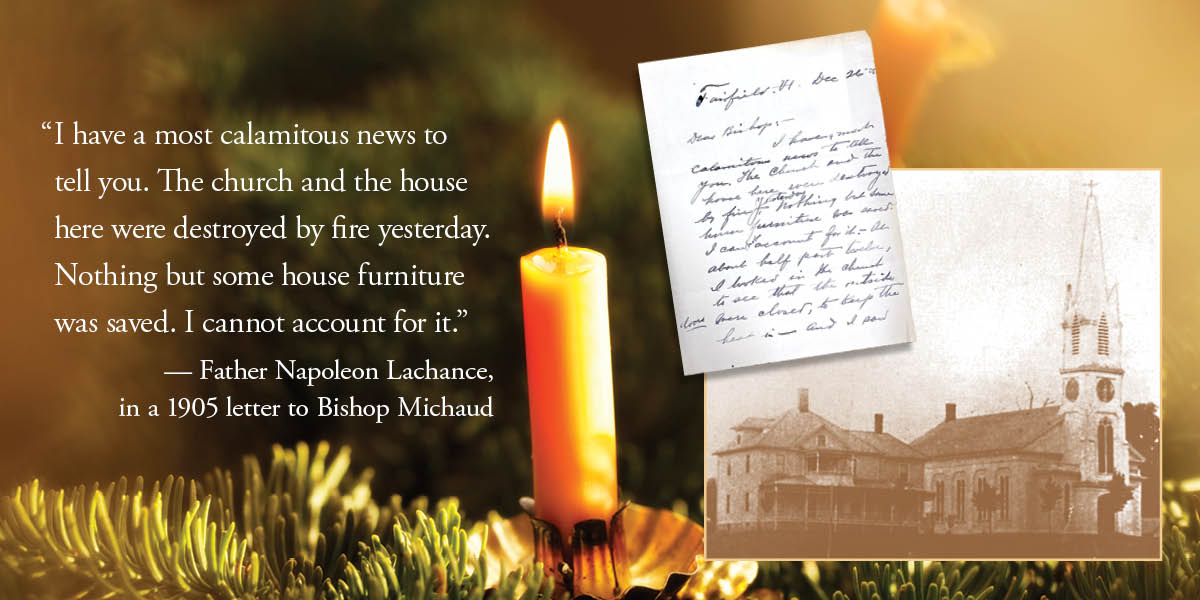
St. Patrick Church – A Christmas Day fire
While rudimentary electric Christmas lights existed since the 1880s and were produced commercially beginning in the early 1900s, they were very expensive, limiting their use as ubiquitous household decorations. Widespread use of electrical holiday lighting only came about in the 1920s and later.
The use of burning candles, combined with fresh-cut evergreens, presented an immense fire risk when decorating for the holidays.
St. Patrick Church in Fairfield fell victim to tragedy on Christmas Day in 1905, likely due to just such a hazard. With only candles to illuminate holiday decorations, the church was most probably adorned with live greenery such as wreaths, garlands, and a Christmas tree. These fresh greens, yet very much in various stages of drying, laden with flammable oils and resins, provided the perfect conditions for an inferno. The beautiful tradition of displaying live greens and candlelight, unrestrained by modern safety practices, proved a lamentable disaster for St. Patrick’s.
‘Most calamitous news’
In a Dec. 26, 1905, letter to Burlington Bishop John Michaud, Father Napoleon Lachance, pastor of St. Patrick Church, reported:
“I have a most calamitous news to tell you. The church and the house here were destroyed by fire yesterday. Nothing but some house furniture was saved. I cannot account for it. At about half past twelve, I looked in the church to see the outside doors were closed, to keep the heat in – and I saw nothing out of the way, hardly more than one hour after the smoke was coming out in heavy clouds from the steeple. This took place at about two o’clock yesterday afternoon.”
St. Patrick’s was erected as a parish in 1847 and proudly housed the Catholic faithful for two decades until this small brick church became much too small to accommodate the growing Catholic population. A much larger, mostly wooden, structure and rectory were built in 1867 to replace it.
On Christmas Day 1905, a major fire broke out at St. Patrick Church that destroyed the building. The fire started well after Christmas Day Masses, and no one was in the building. Those living in the village, enjoying their Christmas gatherings, likely saw smoke emerging from the windows of St. Patrick’s.
Newspaper reports from the time describe the fire as a huge, uncontrollable blaze that lit up the sky and brought out nearly the entire town to help fight it. But Fairfield’s primitive firefighting equipment at the time was no match for the flames – little could be done to save the property. The Burlington Free Press published an article on Dec. 26, 1905, recounting how the church “burned flat to the ground, only parts of the brick walls were left standing.” The article noted it was a “total loss.”
Residents reported the confusion that surrounded the site as attempts were made to save the rectory furnishings: “People were lugging mattresses downstairs and outside but throwing glasses out the window.”
Another recalled, “I remember how nice and warm it was in the church – and how pretty the altar looked trimmed with evergreens and lighted with candles.”
While Father Lachance could “not account for it,” we may see here the likely cause of this fire. Could a candle or two have burned so low and closely to the evergreen decorations? Once ignited, these decorations would have burned intensely, quickly overpowering the building and the town’s firefighting resources. The beautiful tradition of live greens and candlelight, unrestrained by modern safety practices, ended in disaster for St. Patrick’s.
Out of the ashes
Father Lachance and the parishioners wasted no time in gathering resources to supplement the insurance money needed to rebuild. The cornerstone for the present St. Patrick’s was laid in 1906 and a new church was built – directed chiefly by the joint, creative fundraising efforts of Father Lachance and the parishioners of St. Patrick’s for the new construction. The Congregational Church in town volunteered the use of its space to the Catholic community for Mass until 1910 when the new church and rectory were ready to be called “home” by the Catholics of Fairfield.
Sources:
Heaney, J. (1958). Fire Destroyed Fairfield Church 53 years Ago on Christmas Day. Burlington Free Press.
(Dec. 26, 1905). Burlington Free Press.
Lachance, Father Napoleon (Dec. 26, 1905). Letter to Bishop John Michaud.
Wanzer, Ethel, Yates, Mary, and Teague, Matthew. (1968). Annual Report of the Town of Fairfield, Vermont (p. 57).
—Kathleen Messier is the assistant archivist for the Diocese of Burlington. For more information, email archives@vermontcatholic.org.
—Originally published in the Winter 2023 issue of Vermont Catholic magazine.

